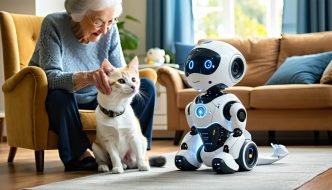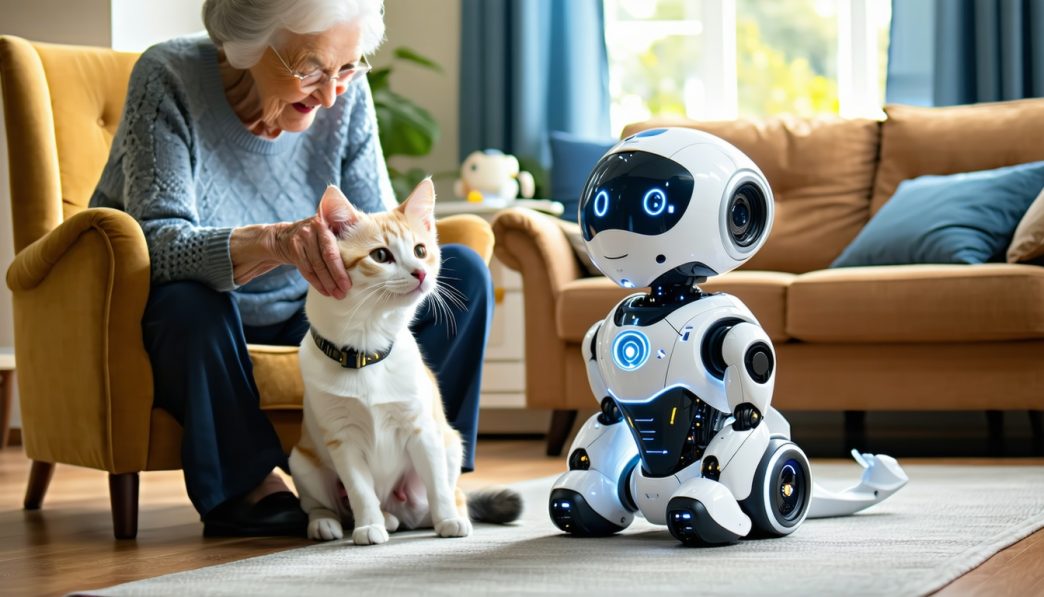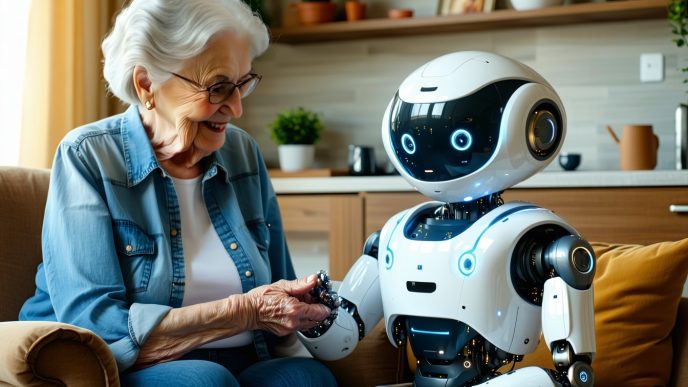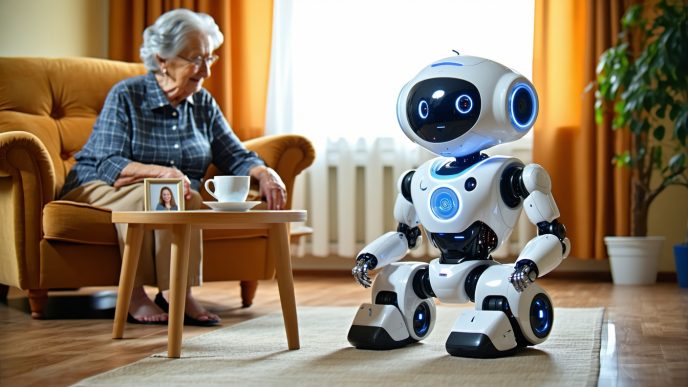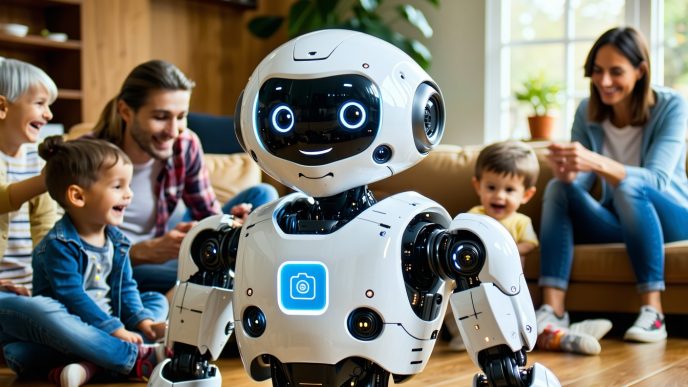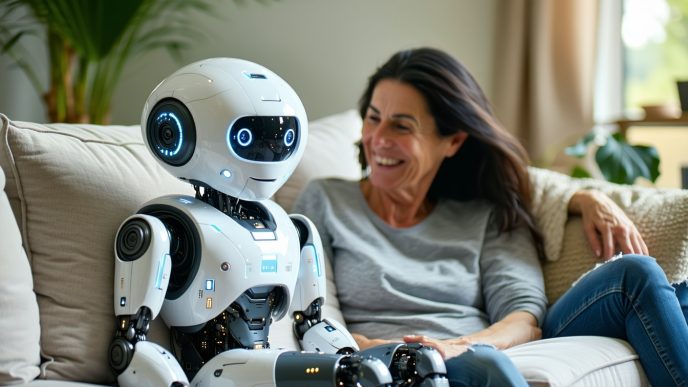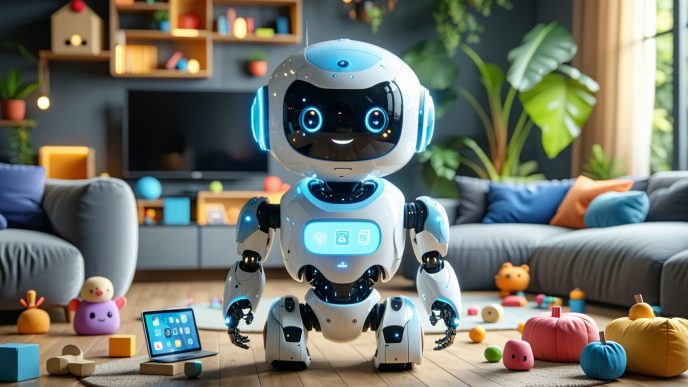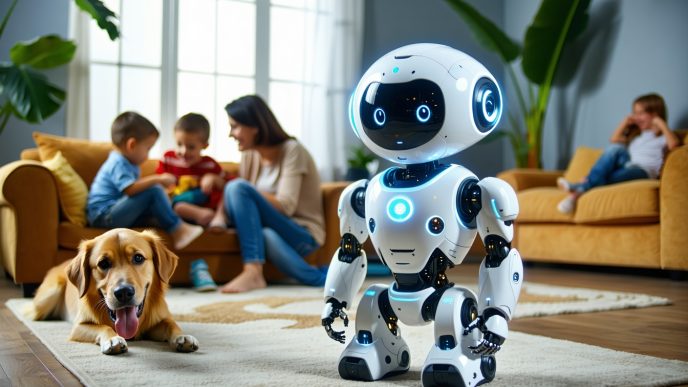Exploring Robot Companionship
As technology evolves, the concept of companionship has expanded beyond traditional relationships to include robotic entities designed to offer emotional support and interaction. Companion robots are becoming an integral part of addressing the needs of older adults facing loneliness and isolation.
The Rise of Companion Robots
The field of robot companionship has seen significant advancement, with an increasing number of devices designed to provide comfort and engagement. These robot pets mimic the behavior of real animals, creating an illusion of companionship without the demanding responsibilities of caring for a living pet. Many of these devices are designed to interact naturally, responding to touch and voice, which enhances the connection and warmth often associated with pet ownership.
| Year | Companion Robot Development Milestones |
|---|---|
| 2000 | Introduction of simple robotic pets |
| 2010 | Development of robots capable of emotional interaction |
| 2020 | Advanced AI integration for responsive companionship |
The surge in companion robots can be attributed to advances in technology, particularly artificial intelligence. Innovations have enabled robots to recognize human emotions and respond accordingly, enhancing their role as supportive companions, especially in environments such as assisted living facilities.
Impact of Loneliness on Older Adults
Loneliness is a prevalent issue among older adults, significantly affecting their mental and emotional health. Research indicates that social isolation can lead to depression, reduced cognitive function, and other health complications. Many older individuals live alone or have limited social engagement, contributing to feelings of emptiness and loneliness.
| Effects of Loneliness on Older Adults | Statistics |
|---|---|
| Increased Depression | 25% of seniors experience depression |
| Cognitive Decline | 40% of older adults report cognitive difficulties due to isolation |
| Elevated Health Risks | Loneliness can increase the risk of heart disease by 29% |
Robot pets for seniors serve as a potential remedy to mitigate these negative impacts. They provide consistent companionship, fostering engagement and interaction that can alleviate the sense of loneliness. By offering emotional connectivity, these robotic companions can spark joy and enhance the quality of life for older adults.
Exploring companionship through robotic pets presents an innovative approach to combating loneliness while meeting the emotional needs of seniors, prompting further investigation into their benefits and applications in various settings, including care for individuals with dementia through companion robots for dementia patients.
Benefits of Robot Pets for Seniors
Robot pets offer numerous advantages for seniors, specifically in promoting emotional well-being, stimulating mental activity, and providing companionship. These benefits contribute significantly to enhancing the quality of life for older adults.
Emotional Support
Robot pets can provide essential emotional support to seniors by offering a sense of comfort and security. Many seniors experience feelings of loneliness and isolation, which can have detrimental effects on their mental health. Robot pets, designed to respond to human interaction, can simulate the nurturing experience associated with having a real pet.
Numerous studies indicate that interacting with robot pets can reduce anxiety and promote feelings of happiness. In a recent survey, older adults who engaged with robotic companions reported a decrease in feelings of loneliness by approximately 60%.
| Emotional Benefits | Percentage of Seniors Reporting Improvement |
|---|---|
| Reduced Loneliness | 60% |
| Increased Happiness | 70% |
| Lowered Anxiety | 55% |
Mental Stimulation
Engaging with robot pets can also aid in providing significant mental stimulation for seniors. Many robotic companions include features that encourage interaction and mental activity, such as playing games, responding to commands, and offering challenges that require problem-solving.
These interactions can help keep the mind active, which is especially beneficial for older adults looking to maintain cognitive function. Studies have shown that regular mental engagement can potentially delay the onset of cognitive decline in seniors. This aspect of robot pets aligns well with the growing interest in technology’s role in promoting mental health.
| Mental Engagement Activities | Description |
|---|---|
| Interactive Games | Engage seniors in problem-solving tasks. |
| Responsive Commands | Encourage cognitive engagement through verbal interaction. |
| Memory Challenge Features | Stimulate memory and recall abilities. |
Companionship
One of the most significant benefits of robot pets is their ability to provide companionship. For many older adults, companionship can alleviate feelings of loneliness, promote social interaction, and improve overall emotional health.
Robot pets can serve as conversational partners, alleviating the absence of human interaction. They can also create opportunities for seniors to share experiences with family members and caregivers, fostering connections through shared activities with the robotic companion. This bonding experience is essential, as it can encourage discussions about the technology and its role in improving life quality.
| Companionship Benefits | Impact on Seniors |
|---|---|
| Alleviated Loneliness | Enhanced emotional well-being |
| Shared Experience Opportunities | Improved family interaction |
| Social Stimulus | Increased social engagement |
By incorporating robot pets into their lives, seniors can experience emotional support, mental stimulation, and companionship. These robotic companions hold the potential to significantly enhance the quality of life for older adults and support their emotional and mental well-being. For further insights into robotics and companionship, explore articles on robot companions for mental health and companion robots in assisted living.
Types of Robot Pets
Robot pets are designed to provide companionship and emotional support, particularly for older adults. This section explores various types of robotic pets that are suitable for seniors, including robotic dogs, robotic cats, and other animal-inspired robots.
Robotic Dogs
Robotic dogs are one of the most popular types of companion robots for seniors. These interactive pets often mimic real dogs by responding to touch and sound. Features may include barking, walking, and even performing tricks, which can evoke an emotional connection similar to that of a real pet.
| Feature | Description |
|---|---|
| Interaction | Responds to voice and touch |
| Mobility | Can walk or move autonomously |
| Sound | Makes barking and playful noises |
| Emotional Connection | Offers companionship and joy |
Robotic dogs can help alleviate feelings of loneliness while also encouraging physical activity. Their playful nature can stimulate engagement and uplift the spirits of seniors.
Robotic Cats
Another option in the realm of robotic pets is robotic cats. These devices often emulate the behaviors of real cats, featuring purring sounds and movements that mimic typical feline behavior, such as curling up and stretching.
| Feature | Description |
|---|---|
| Interaction | Responds to petting and sounds |
| Comfort | Offers a calming presence |
| Playfulness | Engages in play with toys |
| Realistic Features | Mimics grooming and napping |
Robotic cats can provide emotional comfort without the maintenance demands of a live animal, appealing particularly to seniors who may prefer a quieter companion.
Other Animal-Inspired Robots
In addition to robotic dogs and cats, there are other animal-inspired robots available as companions. These include robotic rabbits, birds, and even more exotic options like turtles and dolphins.
| Animal Type | Key Features |
|---|---|
| Robotic Rabbits | Floppy ears, cuddly design |
| Robotic Birds | Singing sounds, colorful designs |
| Robotic Turtles | Slow-moving, calming presence |
| Robotic Dolphins | Playful interactions, movement |
These diverse options offer varying levels of interaction and companionship, allowing seniors to choose a robot that best fits their personality and lifestyle. For more information on how robots can assist older adults, explore articles on companion robots in assisted living or robot companions for mental health.
Each type of robot pet serves a unique purpose and can help combat loneliness while enhancing the overall quality of life for older adults.
Considerations for Seniors
As technology integrates more into the daily lives of older adults, selecting the right robot pets for seniors involves understanding several key factors. These considerations ensure that the robotic companions effectively meet their needs and enhance their well-being.
Ease of Use
For older adults, ease of operation is paramount when it comes to adopting robotic pets. Complicated setups or controls may deter usage and limit the potential benefits of the companion robots. Thus, many manufacturers design these devices with user-friendly interfaces, including simple buttons, voice activation, and straightforward charging methods.
A recent survey found that 85% of seniors prefer devices that require minimal instruction and can be utilized intuitively. Ensuring that the robot pets come with clearly defined manuals or online support can further alleviate concerns regarding usability.
| Feature | Preference Percentage |
|---|---|
| Simple Interface | 85% |
| Voice Activation | 70% |
| Minimal Setup | 90% |
Maintenance and Care
Regular maintenance is essential for ensuring the longevity of robotic pets. Seniors should consider how easy it is to clean the devices, replace batteries, or perform software updates. Companion robots should have durable materials that stand up to daily wear and tear.
It is also important to consider any associated costs with maintaining the robotic pets. Some devices may require subscriptions to access features or updates, while others might need additional purchases for necessary components. Understanding these aspects can assist caregivers and family members in budgeting effectively.
| Maintenance Task | Frequency |
|---|---|
| Battery Replacement | Every 3-6 months |
| Cleaning | Weekly |
| Software Update | As needed (varies by model) |
Compatibility with Lifestyle
Choosing robot pets that align with the lifestyle of the older adult is crucial. Factors such as living arrangements, health conditions, and daily routines can influence the decision. For instance, those residing in assisted living facilities may benefit more from smaller, less interactive robotic companions, while seniors living independently might prefer more responsive and engaging pets.
Additionally, there can be synergy between robot pets and existing technologies in the home. Compatibility with home assistants or other health-monitoring devices enhances the overall experience and provides greater integration into the daily lives of older adults. For further exploration of how robotic pets can assist in various environments, see our article on companion robots in assisted living.
By considering these important factors—ease of use, maintenance and care, and compatibility with lifestyle—families and caregivers can better select the appropriate robot pets for seniors that not only provide companionship but also promote a sense of well-being.
Addressing Loneliness in Older Adults
The Importance of Social Interaction
Social interaction is vital for the emotional and mental well-being of older adults. It plays a key role in reducing feelings of loneliness and isolation. Engaging in regular social activities can lead to improved mental health, cognitive function, and overall quality of life. Studies have shown that seniors who maintain social connections tend to experience lower rates of depression and anxiety.
The inclusion of robot pets as companions for seniors can enhance social interaction, even if they do not replace human contact. Robot pets can encourage conversations, promote engagement, and serve as a bridge to connecting older individuals with family or caregivers. While they may not provide the same depth of interaction as human relationships, they can be a valuable addition to a senior’s life.
| Social Benefits | Description |
|---|---|
| Decreased Loneliness | Regular interaction with robot pets may lower feelings of solitude. |
| Enhanced Engagement | Robots can stimulate conversations and social activities. |
| Mental Health Improvement | Increased social contact can lead to better emotional health. |
Limitations of Robot Companionship
Despite the benefits of companion robots, there are several limitations worth considering. Robot pets cannot replicate the emotional nuances of human relationships. They lack genuine empathy, understanding, and the ability to respond to emotionally complex situations. While they provide interaction, the depth of connection is fundamentally different from that of a human companion.
Additionally, some older adults may find it challenging to adapt to robotic technology. Ease of use varies among different devices, and those who are not technologically inclined may struggle with operating them. Maintenance and care also present challenges, as seniors may require assistance in keeping their robot pets functioning properly.
| Limitations | Description |
|---|---|
| Emotional Disconnect | Robot pets cannot provide true emotional understanding or support. |
| Technological Barriers | Difficulty in operating robotic devices may deter use. |
| Maintenance Needs | Care and upkeep can be a burden for some seniors. |
Robot pets for seniors serve as a valuable tool in addressing loneliness, but it is essential to acknowledge their limitations. They are best used as a supplement to human relationships rather than a complete replacement. Understanding both the benefits and limitations can help caregivers and family members make informed decisions about incorporating companion robots into the lives of older adults.

